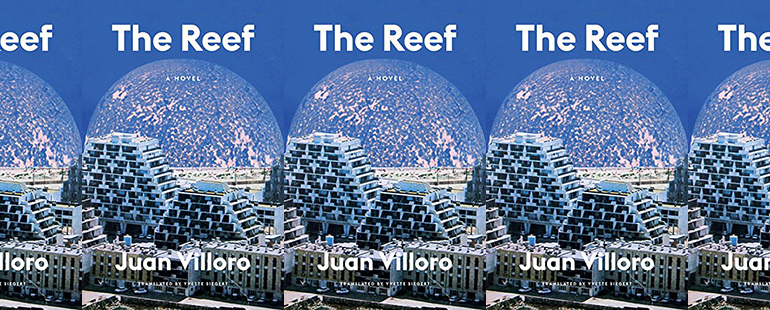“We are forgetting what has already happened in Cancún”: An Interview with Juan Villoro

In his 2012 novel, The Reef, Juan Villoro paints a landscape of lust—scuba divers, yoga instructors, detectives, and security guards lust after each other and their refracted pasts—within The Pyramid, an exclusive resort and “enormous structure modeled after the Temple of the Inscriptions located in Palenque” set in a fictionalized Cancún. The novel follows Tony Gongora, a sound engineer who’s been hired to work at the hotel by his childhood pal Mario Müller. Müller, who manages the property for a cast of shadowy offshore investors whose representative is known as El Gringo Peterson, hires Tony out of a dead-end job because he needs somebody to trust at The Pyramid—or possibly because he has a terminal illness and wants to be around an old friend. This satirization of the all-inclusive resort, a symbol of international tourism, could only be accomplished in a meaningful way by a titan of Mexican letters like Villoro. Not only does he have the qualifications, having published lauded essays, stories, and criticism of Mexican culture since the late 1980s, but he has a unique capacity to create absurdist characters—the type who deliver biting criticism out of the sides of their mouths, but who also have the potential for deep emotional understanding.
Villoro’s work may be new to many English speakers, having only been significantly translated since 2015 (The Reef was translated into the English by Yvette Siegert in 2017), but he’s had an illustrious career south of the border as a cronista, intellectual, and activist. In interviews, Roberto Bolaño has lauded Villoro as an “enormous writer” who “young Spanish writers should be influenced by.” In a section of his 2019 book, On the Plain of Snakes, Paul Theroux writes, “His straightforwardness, imaginatively set out, is but one reason to value Villoro’s work.” The Reef may not seem a straightforward title at first—there are no scenes that take place at an actual reef—but it makes sense in the context of Villoro speaking truth to power, something he does often in his work.
The adverse effect of the tourism industry on the Great Mayan Reef is the disaster that underpins The Reef. Villoro addresses themes of greed and egomania in another of his translated works, a short story collection called The Guilty (translated in 2015 by Kimi Traube). The cast of characters employed there is similar to The Reef in their reference to pop culture iconography, and in their use as social commentary: there’s a mariachi with a masculinity problem, a washed-up professional soccer player in an existential crisis, and an American journalist and a Mexican writer involved in a mutually exploitative relationship. Such character-building serves to satirize forces at work in the larger world, and renders Villoro the optimal craftsman of a novel taking on tourism, environmentalism, and the drug trade.
While there may not be any explicit reef scenes in The Reef, Villoro uses cenotes, underground rivers which lead to the sea, as a device by which characters transport narcotics. He also uses them as a metaphor, connecting them loosely to the Mayans, who “sacrificed their most prized possessions in the fresh-water cenotes. That’s where they’d thrown their jewels and children and princesses and dwarves—all their small, adorable creatures.” The drugs that leave the cenotes end up in my home city of Miami, a connection that piqued my interest. And so, when I saw Villoro would be here for the Miami Book Fair late last November, I set up an interview. We spoke about the shared ecology of the Miami and the Yucatán Peninsula, the future of Mexican politics, and how Mexico’s younger generation is going to take back a scorned countryside.
Jason Katz: Have you been to Miami before? It finds its way into The Reef.
Juan Villoro: I came here about ten or eleven years ago with a Cuban friend, the novelist Eliseo Alberto, so I learned Miami as Cuban place. It was rewarding and interesting. In my book, I used it as a reference for the entire Caribbean. All of the traffic between Mexico, Central America, and the United States goes through Miami. My grandmother was from the Yucatán and there’s a very special connection between the Yucatán, Cuba, and Miami, and around the time she was born, you could also include New Orleans. [Miami] was a country unto itself for a period of time in the nineteenth century. It was difficult to get from Yucatán to the rest of Mexico, but easy to get between those places. For example, if an opera company would do a tour of the region, they would go between Yucatán, Cuba, Miami, and New Orleans.
JK: A Gulf nation-state surrounding a massive asteroid crater!
JV: Yes, the end of the dinosaurs. There is a place called Chicxulub, a Mayan city, that is the home to the scar of that asteroid.
JK: Semi-relatedly, I was wondering about The Reef in the context of ecological fiction. You take environmental disaster and instead of making it what drives the story forward, set the narrative against it.
JV: Environmental disaster is a metaphor for what’s happening to the country and the characters of the story. It’s a novel about things that are breaking. One of the main characters, Mario Müller, is going to die, and he wants to leave something important behind—his memories—but he also wants to save the only child he had, even though she’s never lived with him. His best friend, Tony Gongora, was a wasted man, in and out of rehab. His life was going nowhere and now he suddenly has the opportunity to live a second act. In this context of disillusion, of destruction, both Mario and Tony try to recover something. Tony realizes he can be the one who keeps the memories of his friend and also save the child. So, the climate change situation and the destruction of nature is the metaphor for the whole action and destiny of the characters. The story’s not about the ecology but the ecology serves as the setting in which the stories come to be. These characters can only live these kinds of lives amidst natural devastation.
JK: What do you think is the role of the novelist as it pertains to climate change?
JV: To explore the things that only a novel can say. It’s not the role of the novelist to address the issues as a journalist, scientist, or historian. Environmental problems can have links to mysterious ways of behavior. It rains two hundred days each year in Cancún, which is a disaster for a tourist destination that is meant to offer sun and beaches. How can you cope with this? There’s prostitution and drug smuggling. Tourism is very convenient for hotel owners who want to keep a secret account of their business. It’s very easy for them to run fake numbers, whether it’s their occupancy or rates. Many hotels, in the context of shifting climate, have shifted their business models to money laundering. They’re even building new hotels in places where the occupancy rates are low.
This context creates interesting opportunities for fiction, like the opportunity Mario Müller has taken advantage of. He’s created a kind of theme park for a special kind of tourist, where it doesn’t matter if it rains or not, because they’ll enjoy the wonder and terror of the recreative paranoia experiences he fosters in the Pyramid. There you have a way to not address what is really happening but to instead transform all these realities into literary possibilities. This doesn’t only have to do with country-wide problems, but also [with] the roots of the character.
This is the kind of thing that can happen in Mexico. Many people want special attractions. Not only good experiences, but, strangely enough, humankind enjoys having this adrenaline rush when perial danger and violence are close. [Mario] discovers that people in dangerous circumstances can experience a mental trip. His idea is to create a kind of imaginary citadel in which you are going to have all these circumstances. Are these experiences believable? Of course, because whatever you read about Mexico has to do with danger, kidnappings, guerillas, and earthquakes. These people go to a place where there will be some surprises, but ultimately everything is under control, so they know they’re are in a staged reality where they don’t know what is real and what is fake. All of these things have to do with the way novels explore reality. There are a lot of social facts, but the combination of facts and investigation of possibilities have to do with the very special fates of the characters.
JK: There is a great deal in common between the Yucatán and Miami. Not only the washing of money and ecological disaster, but the characterization as places to go to where things might be wild or dangerous.
JV: Yes, and furthermore, they are places where people can assume another identity. Achieving a new personality is very alluring for many people. It is like that famous saying, “what happens in Vegas stays in Vegas.” Cancún is called Kukulcan in my book because I didn’t want to be forced to depict a real Mexico, but instead explore the possibilities of this reality. To know these possibilities through imaginary characters who have their very specific reasons they would react to their surroundings in the way they do.
JK: There have been some reports on the negative impact of tourism on Tulum’s ecosystem. How have you seen it change?
JV: The whole region is under menace. There’s a project being planned now to build the “Maya Train.” It will go around the entire Yucatán and carry around 4.5 million passengers annually. Cancún receives around five million tourists each year so it will be more or less the same—a moving Cancún. It’s going to have a major impact on the environment of the area. For example, it will go through Calakmul, our second biggest natural preserve (after El Vizcaíno in Baja), and it’s not only the destruction of species by the train’s construction but the vibrations of the train, and the presence of the tourists. The poor people are going to be employees of international corporations. Then on top of all of this, there are unexplored Mayan ruins that geologists know exist only by laser mapping. This train will plow right over them. They are replacing natural resources with a simulated experience. Of course, the Indian communities are against the project. Many former ministers for ecology are against the project. Many journalists are opposed. The money is in favor of it though.
JK: What about politicians?
JV: The president thinks this is going to be a very important project. He’s allegedly a leftist. He’s more a populist and authoritarian and he makes decisions based on what works well for his administration. He thinks there will be major investment in the area. And this is true. The Marriotts and Hiltons of the world will stand to make more as a result of this, but we are forgetting what has already happened in Cancún. There has been total ecological destruction of the area. My novel is called The Reef because the Mexican coral reef is the second largest reef in the world and it’s at risk. There was a chain of destruction that ultimately led to the reef. To build the hotels, the forest was dismantled, and without roots to hold the dirt together, it became sandy, and was washed out to the sea, blocking out the sun to the coral reef.
JK: Going back to the idea of Mario Müller and what he wants to leave behind—it seemed to me that he is a symbol for an entire generation.
JV: Yes, I would say so. His generation had big dreams in the sixties and seventies and then got disappointed and couldn’t cope with what happened thereafter. There were a lot of utopias for sale in the sixties and seventies, and then all that mattered in the world all of a sudden was the capitalist structure. All of the radical transformations hit a dead end. Communism was no longer an illusion because of what we saw happen in the Soviet Union and Cuba. Free love was longer an illusion after the AIDS crisis. Going to the field and building a hippie commune lost its appeal as climate change onset and we couldn’t control the environment as much as we needed to. All these utopias suffered from a kind of reality check. What can you do after that?
Mario finds this strange way to deal with this. There are alternatives. In one passage in the book, I speak about technology as another form of LSD. Virtual reality has become such an alternative for many people. It’s not primarily about taking drugs anymore but the possibility of existing in parallel worlds. San Francisco of today is the home of this geek community. The main difference between today and yesterday was while counterculture of sixties and seventies had its business elements, it wasn’t big business that could transform the economy of the world like tech today. Mario belongs to this generation that was disappointed by losing the dreams of the counterculture but at the same time he wants to save something. He decides to invent attractions.
JK: In the states there are again movements focused on developing green utopias and intentional living communities. Do you see this in Mexico?
JV: What’s happening in Mexico today is the acknowledgement of the original settlers of the country—the Indian community. Looking at them not as from the past, but as belonging to the future. There’s a generation of people from the Indian community who have studied in universities or are very capable at communicating through the internet. They are deeply into ecology, permaculture, and these things. There’s a connection between them and Mexican millennials who want to live greener lives and preserve nature starting from its roots. This is different from us urbanites who used to say, Let’s go live a different way on the land. Today it’s more, Let’s go to the Indian communities and learn something. Let’s get together and share goals.
One of the main problems in Mexico is that we have much deserted land. When the revolution started in 1910, eighty percent of Mexicans lived in the countryside. Today, eighty percent of people live in cities. Mexican agriculture is almost dead. The land is empty, and this is the place where narcos can hide and smuggle drugs. The only way to reclaim it is to accept the knowledge of its original settlers. This would be a revolution not only from a multicultural perspective but also ecologically. We are losing sovereignty because the narcos control tons of land and thus the states. The Indians of Mexico benefit from an entire millennium of knowledge. They are not using pesticides, just more sustainable farming techniques. There has been a raising of awareness in the last ten years of these issues. I was deeply involved in the candidacy of an Indian woman who wanted to be president of Mexico. Her name is Marichuy Patricio. She didn’t make it to the ballot. In Mexico, you need one million signatures, but to avoid corruption, they say, it must be done in an app on a smartphone. Some of the Indian communities don’t even have power, let alone cell phones. Although Marichuy didn’t make it, the visibility made a major impact. We got 300,000 signatures.



